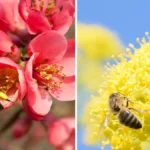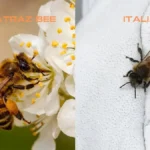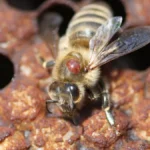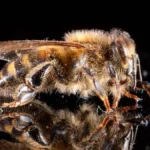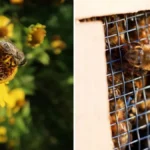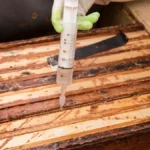When comparing Russian honey bees vs Italian bees it is a bit like comparing a Wooly Mammoth with an Elephant. We will delve into the differences between these two exceptional honeybees in this article.
What Are Russian Bees?
Russia is actually very big. When we talk about Russian bees as a “breed” we are referring to a very specific line of bees that were imported to the US from the Primorsky Krai region in Russia. A limited number of queens were imported by the Baton Rouge Bee Laboratory in the 1990s and a breeding program was set up on the isolated barrier island of Grand Terre.
The main reason for importing and developing the “Russian” strain was that these bees exhibit greater resistance to Varroa and Tracheal mites. The Primorsky Krai region is in the far East of Russia. The indigenous bee in this area is Apis cerana.
Beekeeping developments in that region had resulted in Apis mellifera being introduced into the region from Western and Central Europe. The varroa mite is endemic to the area and resides in the indigenous A.cerana hives. These mites then jumped hosts and infected the introduced Apis mellifera. The result was the development of the Apis mellifera Far Eastern breed. This occurred about 150 years prior to the queens being imported to the US.
The Russian Honey Bee Breeders Association was established to maintain the purity of the imported Russian bee strain in the USA.
What Are Italian Bees?
Italian bees, or Apis mellifera ligustica, is the race of Apis mellifera that is present in continental Italy. This bee is an industrious hardworking bee that is kept by beekeepers around the world. I have seen this bee in regions as diverse as the EU, US, Canada, Chile, Argentina, and India!!
Italian bees are, gentle, excellent honey producers but demonstrate susceptibility to varroa and tracheal mites. I find this bee to be beautiful – lovely golden in color. It is quite a big “goofy” bee for want of a better word. It faffles around on flowers, compared to smaller races which are more agile.

Learn more about: Carniolan vs Russian Bees
Russian Honey Bees vs Italian Bees
There are a number of important places we need to compare the characteristics of these two bees.
Varroa and Tracheal Mite Resistance
Russian bees are at least two times more resistant to the varroa mite. This makes a huge difference to the survival of beehives as it reduces the explosive growth in mites. Russian bees are also able to completely shut down their brood nests, which means that mites have nowhere to hide and are easier to kill.
Russian bees also demonstrate superior Tracheal mite resistance compared to Italian bees. Brother Adam curiously noted that the darker strains of Italian bee found in the mountains were more resistant to Tracheal mite. The dominant Italian strains found globally however tend to be the lighter orange strains.
In this regard, Russian bees are the winners in terms of mite resistance.
Honey Production
Italian bees are exceptional honey producers, and if managed correctly, they will produce huge honey crops. Russian bees likewise are considered above average honey producers and with correct management, they can also produce huge crops. Hence both bees require management to reach optimal performance on honey production and crops will be more a symptom of the beekeeper than the bee.
Aggression
Russian bees can get a little aggressive. In cases where these bees cross with other bees, the offspring can be even more erratic. My personal experience with working with all sorts of races of bees is that excessive aggressiveness in bees is often a case of a beekeeper just not reading the language of the bee. That said, I have been chased away from a Russian hive once by a bunch of angry guard bees.
Italian bees are not very aggressive – if you are used to these bees, then you will probably find any other bee aggressive. If you are used to Italian bees you will be a bit lazy with the smoker, and rougher than necessary. Treat bees well and you can work any bee easily. I have worked bees in the Congo with just a smoker and a t-shirt. No stings. But if I had worked those bees as though they were Italian bees!!! Every dog, chicken, bird, person, crocodile, and whatever else was hiding in the jungle within half a mile would have been stung.
Winter Cluster and Brood Rearing
Russian bees have this one sorted. They are excellent winter cluster formers and are able to regulate or shut brood-rearing depending on climatic variables. They form a dense winter cluster and consume winter stores efficiently. Colonies enter spring healthy and rear brood explosively. This can cause huge increases in population and swarm impulses. Hence swarm management is important. Requeening Russian hives with Russian queens is relatively easy.
Italian bees are able to overwinter in certain parts of the US but form a loose cluster that is less efficient. They require considerable stores to make it through winter. Their brood-rearing urge is quite strong and they can get tempted to rear brood a bit early. This can cause colonies to collapse. In some cases, beekeepers try to feed pollen patties to supplement the hive. This, in turn, can cause small hive beetle problems.
Swarming
Russian bees are inclined to increase the number of bees in a hive rapidly, which can, if unmanaged, cause swarming. It is important to conduct very regular (weekly) inspections of the brood nest and remove swarm cells. There is also a strong need to manage the brood nest, adding fresh frames and sometimes removing brood.
Italian bees are some of the least inclined to swarm of all bees. Because this bee has been bred most likely more than any other bee, it has had a lot of its natural instincts bred out.
Robbing
Italian bees tend to drift between hives, and this can, during periods of nectar dearth trigger robbing. Because the bees are poor propolizers, the hives are more susceptible to robbing. Italian bees have a strong brood-rearing urge, hence they can be forced to rob if they run out of resources.
Russian bees do not drift as much, have more serious guard bees, and tend to shut down brood rearing quickly if pollen and nectar dearth occurs. In this regard, the bees are far less likely to trigger robbing incidents.
How To Choose?
Your choice of bee will be based on your local climate and the prevalence of pests. If you have a warm long summer and a mild winter, then Italian bees and a good mite management program is a sound choice.
If you have a colder climate, sporadic nectar, and pollen flows, and your bees are exposed to more stress, their susceptibility to disease increases. Keeping Russian bees, with their greater disease resistance, and more environmentally responsive brood-rearing behavior makes sense.
I have been to many beekeeping conferences and meetings and beekeepers argue over races of bees like sportspeople over teams. Some people work well with certain types of bees, and badly with others. In most cases, it is as much a case of pairing the right type of bee with the beekeepers, as it is about choosing the “best” strain of bee.
I hope this article helped you understand how to compare Russian honey bees vs Italian bees. If you enjoyed this article please share. And remember to order your queens early!! With half the world wanting to start beekeeping, queen availability is declining due to high demand.
Read more about: Carniolan Honey Bees vs Italian Honey Bees

Dr. Garth A. Cambray is a Canadian/South African entrepreneur and beekeeper with 28 years of experience in apiculture and specializes in adding value to honey. His Ph.D. research developed a new advanced continuous fermentation method for making mead that has resulted in a number of companies globally being able to access markets for mead. His company, Makana Meadery, exports honey mead to the USA where it is available to discerning connoisseurs. He has also developed technologies to commercially manufacture organic honey vinegar in Zambia for export globally. He holds a few patents globally in the ethanol industry and believes in technology and knowledge transfer for human development and environmental sustainability. One of his proudest achievements is the fact that the wind farm he started at one of his old apiary sites has essentially made his hometown carbon neutral.

